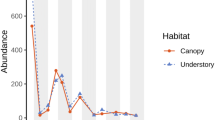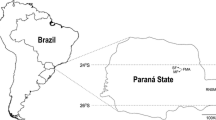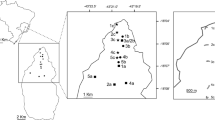Abstract
Colombian tropical dry forest is considered the most endangered tropical biome due to anthropic activities. Desierto de la Tatacoa (DsT) is an example of high disturbed tropical dry forest which still maintains a high biodiversity. The objective of the study was to record the diversity and phenology of wild bees in this place by monthly sampling between December 2014 and December 2016 in a 9-km2 area. During the study, there was a prolonged El Niño–Southern Oscillation period. Bees were collected by entomological nets, malaise traps, eugenol scent trapping, and nest traps. Shannon index was calculated to estimate diversity and Simpson index to determine dominance of a species. The effect of environmental conditions (wet and dry season) in richness and abundance was analyzed by paired T tests. A total of 3004 bee specimens were collected, belonging to 80 species from Apidae, Megachilidae, Halictidae, and Colletidae. Apidae was the most diverse. Shannon index value was 2.973 (discarding Apis mellifera Linnaeus 1758 data); thus, DsT can be considered as a zone of high wild bee diversity. Dry and rainy season showed differences in diversity (p < 0.05). Rainy season showed larger blooming periods and higher bee diversity than dry season. In both seasons, social species were dominant (e.g., A. mellifera or Trigona fulviventris Guérin 1844). Although DsT is a highly disturbed ecosystem, this study found it has the second highest number of genera and the fourth highest number of species reported in Colombia.


Similar content being viewed by others
References
Acosta-Galvis AR (2012) Anfibios de los enclaves secos en la ecorregión de La Tatacoa y su área de influencia. Biota Colombiana 13(2):182–210 ISSN 0124-5376
Ascher JS, Pickering J (2013) Bee Species Guide (Hymenoptera: Apoidea: Anthophila). http://www.discoverlife.org/mp/20q?guide=Apoidea_species Accessed 3 Feb 2017
Ayoade J (1983) Introduction to climatology for the tropics. John Wiley and Sons, New York, 258p
Bonilla-Gómez MA, Nates-Parra G (1992) Abejas euglosinas de Colombia (Hymenoptera: Apidae) I. Claves ilustradas. Caldasia 17:149–172
Cardona J, Arango CI (1983) Inventario de la fauna apoidea (Insecta: Hymenoptera) del Valle de Aburrá y sus relaciones con la flora. Universidad de Antioquia, Medellín, Colombia, BSc. Thesis, p 162
Chacón P, Osorio-García AM, Achury R, Bermúdez-Rivas C (2012) Hormigas (Hymenoptera: Formicidae) del Bosque seco Tropical (Bs-T) de la cuenca alta del río Cauca, Colombia. Biota Colombiana. 13(2):185–181
Colwell RK (2013) EstimateS: Statistical estimation of species richness and shared species from samples.Version 9
Deutsch CA, Tewksbury JJ, Huey RB, Sheldon KS, Ghalambor CK, Haak DC, Martin PR (2008) Impacts of climate warming on terrestrial ectotherms across latitude. PNAS 105:186668–186672
Espinal T, Montenegro YE (1977) Formaciones vegetales de Colombia. Memoria explicativa sobre el mapa ecológico de Colombia. Instituto Geográfico Agustín Codazzi (IGAC), Bogotá, Colombia, 1:238 p
Figuera-Cardozo Y, Galeano G (2007) Lista comentada de las plantas vasculares del enclave seco interandino de la Tatacoa (Huila, Colombia). Caldasia 29(2):263–281
Flórez J, Lucia M, González VH (2015) Notes on the melittofauna from La Tatacoa Desert, Huila, Colombia Boletín del Museo Entomológico Francisco Luis Gallego 7–12
Gómez-Restrepo MA (2010) Fenología Reproductiva de Especies Forestales Nativas Presentes en la Jurisdicción de CORANTIOQUIA: Un Paso Hacia su Conservación Corporación Autónoma Regional del Centro de Antioquia. Antioquia 1:210–218
González VH (2014) Abejas del bosque seco. In: Pizano C, García H (eds) El Bosque Seco Tropical en Colombia. Instituto de Investigación de Recursos Biológicos Alexander von Humboldt (IAvH), Bogotá, pp 214–227
González VH, Engel MS (2004) The tropical Andean bee fauna (Insecta: Hymenoptera: Apoidea), with examples from Colombia. Entomol Abhandl 62(1):65–75
González VH, Gonzalez MM, Cuellar Y (2009) Notas biológicas y taxonómicas sobre los abejorros del maracuyá del género Xylocopa (Hymenoptera: Apidae, Xylocopini) en Colombia. Acta Biol Colomb 14:31–40
Janzen DH (1988) Management of habitat fragments in a tropical dry forest: growth. Ann Missouri Bot Garden 75(1):105–116
Londoño LV, Torres AM (2015) Estructura y composición vegetal de un bosque seco tropical en regeneración en Bataclán (Cali, Colombia). Colomb Forestal 18(1):71–85
Machado IC, Lopes AV (2004) Floral traits and pollination systems in the Caatinga, a Brazilian tropical dry forest. Ann Bot 94(3):365–376. https://doi.org/10.1093/aob/mch152
Magurran AE (1988) Ecological diversity and its measurement. Princeton University Press, Princeton, U.S.A, (1): 192p
Meléndez RV, Ayala R, Delfín GH (2016) Temporal variation in native bee diversity in the tropical sub-deciduous forest of the Yucatan Peninsula, Mexico. Trop Conserv Sci 9(2):718–734
Michener CD (2007) The bees of the world. The Johns Hopkins University Press, Baltimore, p 913
Pizano C, García H (Eds) (2014) El Bosque Seco Tropical en Colombia. Instituto de Investigación de Recursos Biológicos Alexander von Humboldt (IAvH). Bogotá, D.C., Colombia (1): 353
Quesada M (2010) Informe final del proyecto “Evaluación de los impactos del cambio climático en polinizadores y sus consecuencias potenciales en el sector agrícola en México”. http://wwwineccgobmx/descargas/cclimatico/2010_polinizadorespdf Accessed 10 Feb 2017
Roubik DW (1992) Ecology and natural history of tropical bees. Cambridge University Press, NewYork
Ruiz A, Santos M, Soriano PJ, Cavelier J, Cadena A (1997) Relaciones Mutualísticas entre el Murcielago Glossophaga longirostris y las Cactáceas Columnares en la Zona Árida de La Tatacoa, Colombia. Biotropica 29(4):469–479. https://doi.org/10.1111/j.1744-7429.1997.tb00041.x
Silveira FA, Melo GA, Almeida EAB (2002) Abelhas Brasileiras: Sistemática e Indificação. Fernando A. Silveira, Belo Horizonte, Brasil, p 253
Smith-Pardo AH (2007) Diversidad de abejas (Hymenoptera: Apoidea) en estados sucesionales del bosque húmedo tropical. Acta Biol Colomb 12(1):43–56
Torres AM, Adarve JB, Cárdenas M, Vargas JA, Londoño V, Rivera K, Home J, Duque OL, González AM (2012) Dinámica sucesional de un fragmento de bosque seco tropical del Valle del Cauca, Colombia. Biota Colombiana 13(2):66–87
Vásquez AJ, Correa A (1976) Estudio sobre la fauna Apoidea y sus relaciones con la flora y el medio ambiente en la región de Llano Grande (Río Negro, Antioquia). Universidad Nacional de Colombia, Sede Medellín, BSc. Thesis
Vélez-Ruiz RI (2009) Una aproximación a la sistemática de las abejas silvestres de Colombia. Universidad Nacional, Medellin, Colombia, M. Sc. Thesis
Vivallo F, Vélez D (2016) A synopsis of the subgenus Centris (Hemisiella) Moure, 1945 (Hymenoptera: Apidae: Centridini) in Colombia, with description of a new species. Zootaxa 4162(1):107–133. https://doi.org/10.11646/zootaxa.4162.1.5
Vivallo F, Vélez D, Fernández F (2016) Two new species of Centris (Aphemisia) Ayala, 2002 from Colombia with a synopsis of the subgenus for the country (Hymenoptera: Apidae: Centridini). Zootaxa 4093(2):201–216. https://doi.org/10.11646/zootaxa.4093.2.3
Williams NM, Minckley RL, Silveira FA (2001) Variation in native bee faunas and its implications for detecting community changes. Cons Ecol 5(1):7
Acknowledgments
We would like to thank to Nueva Granada University (CIAS 1785-2015) and Professional Biology Council for the financial support of project. We would also thank Professor Gabriel Melo, Universidade Federal do Paraná, and Felipe Vivallo, Universidade Federal do Rio de Janeiro, for their help in the identification of the bees and Paola Cruz, from Université du Québec à Montréal, for her comments and suggestions that improved this manuscript.
Author information
Authors and Affiliations
Corresponding author
Additional information
Edited by Fernando B Noll – UNESP
Electronic supplementary material
Supplementary material
List of bee species collected at “Desierto de La Tatacoa” (DsT). * = new record for Colombia. ** = bees collected on preliminary sampling (XLSX 11 kb)
Rights and permissions
About this article
Cite this article
Poveda-Coronel, C.A., Riaño-Jiménez, D. & Cure, J.R. Diversity and Phenology of Wild Bees in a Highly Disturbed Tropical Dry Forest “Desierto de la Tatacoa”, Huila–Colombia. Neotrop Entomol 47, 786–790 (2018). https://doi.org/10.1007/s13744-017-0578-z
Received:
Accepted:
Published:
Issue Date:
DOI: https://doi.org/10.1007/s13744-017-0578-z




